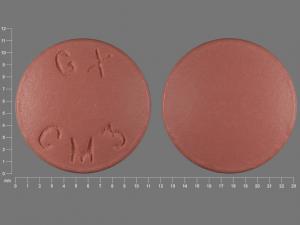Malarone Disease Interactions
There are 4 disease interactions with Malarone (atovaquone / proguanil).
Proguanil (applies to Malarone) severe renal impairment
Major Potential Hazard, Moderate plausibility. Applicable conditions: Renal Dysfunction
Atovaquone and Proguanil tablets are contraindicated for prophylaxis of P. falciparum malaria in patients with severe renal impairment (creatinine clearance <30 mL/min) because of pancytopenia in patients with severe renal impairment treated with proguanil. Use with caution for the treatment of malaria in patients with severe renal impairment, only if the benefits of the 3-day treatment regimen outweigh the potential risks associated with increased drug exposure. No dosage adjustments are needed in patients with mild (creatinine clearance 50 to 80 mL/min) or moderate (creatinine clearance 30 to 50 mL/min) renal impairment.
References
- (2001) "Product Information. Malarone (atovaquone-proguanil)." Glaxo Wellcome
Atovaquone (applies to Malarone) gastrointestinal absorption
Moderate Potential Hazard, High plausibility. Applicable conditions: Anorexia/Feeding Problems, Malabsorption Syndrome, Diarrhea
Oral bioavailability of atovaquone is limited under fasting conditions, but is increased approximately two-fold when administered with food. Patients with gastrointestinal disorders or eating difficulties may be more likely to have impaired absorption and, consequently, subtherapeutic levels of the drug. Alternative parenteral treatment should be considered for patients unable to achieve adequate plasma concentrations of atovaquone with oral administration.
References
- Rolan PE, Mercer AJ, Weatherley BC, Holdich T, Ridout G, Meire H (1992) "Investigation of the factors responsible for a food-induced increase in absorption of a novel antiprotozoal drug 566C80." Br J Clin Pharmacol, 33, p534-5
- (2002) "Product Information. Mepron (atovaquone)." Glaxo Wellcome
Atovaquone (applies to Malarone) liver disease
Moderate Potential Hazard, Moderate plausibility.
Atovaquone may cause elevated liver function tests. In clinical trials, elevated serum alkaline phosphatase concentrations (> 2.5 times the upper limit of normal, or ULN) were reported in approximately 8% of patients, and elevations in serum ALT and AST (> 5 times ULN) were reported in 6% and 4% of patients, respectively. Increases in serum bilirubin has occurred rarely. Atovaquone also may undergo limited metabolism by the liver. Therapy with atovaquone should be administered cautiously in patients with severe hepatic impairment. Liver function tests should be performed periodically, and therapy withdrawn if significant elevations develop.
References
- (2002) "Product Information. Mepron (atovaquone)." Glaxo Wellcome
Proguanil (applies to Malarone) hepatic impairment
Moderate Potential Hazard, Moderate plausibility. Applicable conditions: Liver Disease
No proguanil dosage adjustments are needed in patients with mild or moderate hepatic impairment, however, no trials have been conducted in patients with severe hepatic impairment. Caution is advised, as elevated liver laboratory tests and cases of hepatitis and hepatic failure requiring liver transplantation have been reported with prophylactic use of atovaquone and proguanil hydrochloride tablets.
References
- (2001) "Product Information. Malarone (atovaquone-proguanil)." Glaxo Wellcome
Malarone drug interactions
There are 93 drug interactions with Malarone (atovaquone / proguanil).
Malarone alcohol/food interactions
There is 1 alcohol/food interaction with Malarone (atovaquone / proguanil).
More about Malarone (atovaquone / proguanil)
- Malarone consumer information
- Check interactions
- Compare alternatives
- Pricing & coupons
- Reviews (43)
- Drug images
- Side effects
- Dosage information
- During pregnancy
- Generic availability
- Drug class: antimalarial combinations
- En español
Related treatment guides
Drug Interaction Classification
| Highly clinically significant. Avoid combinations; the risk of the interaction outweighs the benefit. | |
| Moderately clinically significant. Usually avoid combinations; use it only under special circumstances. | |
| Minimally clinically significant. Minimize risk; assess risk and consider an alternative drug, take steps to circumvent the interaction risk and/or institute a monitoring plan. | |
| No interaction information available. |
Further information
Always consult your healthcare provider to ensure the information displayed on this page applies to your personal circumstances.


